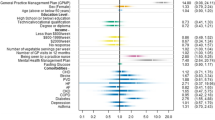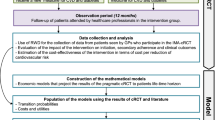Abstract
Background
Coronary heart disease (CHD) is the most common cause of death in the UK. CHD cost the UK National Health Service (NHS) £3.5 billion in 2003. The economic impact of community pharmacists providing a medicines management service for patients with CHD has not been rigorously evaluated; the full economic costs of such interventions are rarely presented in the literature.
Objective
To examine the incremental costs of a 1-year community pharmacistled medicines management service for patients with CHD in the UK, from a healthcare system and patient perspective.
Methods and participants
A cost-minimisation analysis was conducted alongside a multicentre randomised controlled trial. The primary study participants were patients with CHD identified from general practice computer records. Patients (intervention, n = 980; control, n = 500) from 38 general practices in nine geographical areas in the UK were included in the study.
Intervention and outcomes measures
The intervention consisted of a review of pharmaceuticals and lifestyle advice by pharmacists in their premises, with recommendations communicated to the patient’s GP. The main outcome measure was the incremental cost per patient in the intervention group compared with the control group. Annual costs (£, 2003/4 values) included the costs of the intervention (training and delivery costs), the usual costs of NHS treatment (costs of pharmaceuticals, GP and hospital visits) and costs borne by patients. Data were collected in the 12 months before and 12 months after the intervention.
Results
The total NHS cost increased between baseline and follow-up in both groups (from £1243 to £1286 [3%] in the control group and from £1410 to £1433 [2%] in the intervention group).The greater cost in the intervention group largely reflects the additional cost of the pharmacist training and the time taken to deliver the intervention; the difference in costs between the intervention and control groups, after controlling for differences in costs at baseline at follow-up, was statistically significant (p = 0.001). The costs of pharmaceuticals was higher in the intervention group (£769.20 vs £742.3; p = 0.04).
According to the sensitivity analysis, the intervention cost would need to decrease by 35% to achieve equivalence between costs in each arm of the trial. Difference to costs of patients and their carers at follow-up were not statistically significant.
Conclusions
The introduction of a 1-year pharmacist-led medicines management service is likely to increase the total cost of CHD treatment and prevention from the healthcare perspective, as the cost of the intervention outweighed the observed reduction in the cost of drugs in the intervention group. No changes in costs from the patient perspective were found.






Similar content being viewed by others
References
Marmot M, Elliott P. Coronary heart disease epidemiology: from aetiology to public health. 2nd ed. London: Oxford University Press, 2005
British Heart Foundation Statistics. Health survey for England 2003 [online]. Available from URL: http://www.heartstats.org [Accessed 2007 Mar 31]
Department of Health. National service framework for coronary heart disease, 2000 [online]. Available from URL: http://www.dh.gov.uk/PolicyAndGuidance/HealthAndSocialCare Topics/CoronaryHeartDisease/CoronaryArticle/fs/en?.content_ID=4108602&chk=nf93gd [Accessed 2006 Feb 28]
Lutener S, Rhodes H. What do the contract regulations mean? Pharmaceutical J 2005; 275: 692–693
Departments of General Practice and Primary Care, and Management Studies, University of Aberdeen. Evolution and change in community pharmacy: synopsis, November 2003. London: Royal Pharmaceutical Society of Great Britain, 2003 [online]. Available from URL: http://www.rpsgb.org.uk/pdfs/chevcommphsyn.pdf [Accessed 2006 Feb 28]
The Community Pharmacy Medicines Management Project Evaluation Team. The MEDMAN study: a randomised controlled trial of community pharmacyled medicines management for patients with coronary heart disease. J Fam Pract 2007; 24 (2) [online]. Available from URL: http://fampra.oxfordjournals.org/current.dtl#randomised_controlled_trial [Accessed 2007 Apr 23]
National Prescribing Centre (NPC). Medicines management [online]. Available from URL: http://www.npc.co.uk/mms/mmsc/index.htm [Accessed 2006 Sep 30]
Briggs A, O’Brien BJ. The death of cost-minimisation analysis. Health Econ 2001; 10: 179–184
British National Formulary. 46th ed. London: British Medical Association and Royal Pharmaceutical Society of Great Britain, 2003
Chemist and Druggist directory 2003. Tonbridge: CMP Information Limited, 2002
Proprietor’s Association of Great Britain (PAGB). OTC directory 2002/03: treatment for common ailments. London: PAGB, 2003
Netten A, Curtis L. Unit costs of health and social care. Canterbury: University of Kent, 2003
NHS reference costs [online]. Available from URL: http://www.doh.gov.uk/nhsexec/REFCOSTS/2002appl.xls [Accessed 2004 Jan 31]
Automobile Association (AA) motoring costs 2002 [online]. Available from URL: http://www.theaa.com/staticdocs/pdf/allaboutcars/fuel/petrol2002.pdf [Accessed 2004 Apr 30]
HM Treasury. The green book: appraisal and evaluation in central government. London: The Stationary Office, 2003
Department of Transport. COBA 9 manual. London: Department of Transport, 1989
Vickers A, Altaian D. Analysing controlled trials with baseline and follow-up measurements. BMJ 2001; 233: 1123–1124
Wooldridge JM. Econometric analysis of cross section and panel data. Cambridge (MA): MIT Press, 2002
Greene W. Econometric analysis. 5th ed. New Jersey (NJ): Prentice Hall, 2003
Heckman J. Sample selection bias as a specification error. Econometrica 1979; 47: 153–161
Liu JL, Maniadakis N, Gray A, et al. The economic burden of coronary heart disease in the UK. Heart 2002; 88: 597–603
Pacini M, Smith R, Wilson E, et al. Home-based medication review in older people: is it cost effective? Pharmacoeconomics 2007; 25 (2): 171–180
Reilly V, Cavanagh M. The clinical and economic impact of a secondary heart disease prevention clinic jointly implemented by practice nurse and pharmacist. Pharm World Sci 2003; 2: 294–298
Last JM. A dictionary of epidemiology. Oxford: Oxford University Press, 2001
Acknowledgements
The views expressed are those of the authors. This study was funded by the British Department of Health and was managed jointly by a consortium of national pharmacy bodies led by the PSNC. The Health Economics Research Unit is funded by the Scottish Executive Health Department and the University of Aberdeen, Aberdeen, Scotland.
The authors have no conflicts of interest relevant to the content of the study. C. Bond had full access to all the data in the study and final responsibility for the decision to submit for publication.
The Community Pharmacy Medicines Management Evaluation Team included the following:
University of Aberdeen, Abderdeen, Scotland: Christine Bond, Philip Hannaford, Mariesha Jaffray, Amanda J. Lee, Gladys McPherson, Anthony Scott, Michela Tinelli, Margaret Watson, Elizabeth Dinnie and Elizabeth Shirran.
University of Keele, Keele, Staffordshire, England: Alison Blenkinsopp, Steve Chapman, Helen Hooper and Duncan Short.
University of Nottingham, Nottingham, England: Claire Anderson, Anthony Avery, Paul Bissell and Stacey Sadler.
The College of Pharmacy Practice, Coventry, England: Janet Krska.
The authors would like to thank the patients and healthcare professionals who took part in the study, the PSNC and all the local project and research coordinators who helped with the delivery of the service, and the secretarial staff (H. Robertson, A. McAteer, A. Thompson, M. Ross) who helped with the project.
Author information
Authors and Affiliations
Corresponding author
Electronic supplementary material
Rights and permissions
About this article
Cite this article
Scott, A., Tinelli, M. & Bond, C. Costs of a Community Pharmacist-Led Medicines Management Service for Patients with Coronary Heart Disease in England. Pharmacoeconomics 25, 397–411 (2007). https://doi.org/10.2165/00019053-200725050-00004
Published:
Issue Date:
DOI: https://doi.org/10.2165/00019053-200725050-00004




